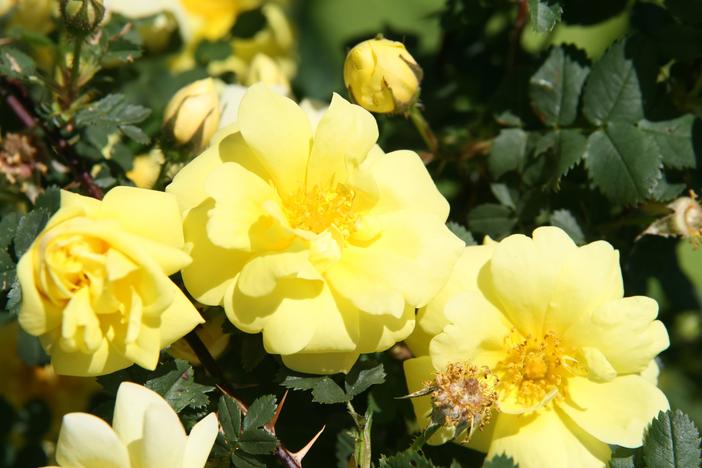Harison’s Yellow
(Rosa ×harisonii)
Harison’s Yellow (Rosa ×harisonii)
/
/

David J. Stang
CC BY-SA 4.0
Image By:
David J. Stang
Recorded By:
Copyright:
CC BY-SA 4.0
Copyright Notice:
Photo by: David J. Stang | License Type: CC BY-SA 4.0 | License URL: https://creativecommons.org/licenses/by-sa/4.0 | Uploader: David Stang | Publisher: Wikipedia Commons







Estimated Native Range
Summary
Rosa ×harisonii, commonly known as Harison’s Yellow, also referred to as the Yellow Rose of Texas or Oregon Trail Rose, is a deciduous hybrid perennial shrub. It is native to the United States and has adapted to a variety of habitats, including open woodlands and prairies. This rose typically grows at a moderate rate to a height and width of 3-6 feet (0.9-1.8 meters). Harison’s Yellow is characterized by its vibrant yellow flowers that are particularly showy in the spring and early summer, with a less frequent bloom cycle extending into the summer months. The plant’s foliage is a deep green, providing a striking contrast to the bright flowers.
Harison’s Yellow is valued for its historical significance and cheerful, bright yellow blooms which make it a popular choice for heritage gardens and cottage-style landscapes. It is also used in border plantings and as a specimen shrub. This rose is relatively easy to maintain, requiring only moderate water once established and thriving in a range of soil types, including clay, loam, and sandy soils. It prefers full sun to part shade, which encourages the best flowering performance. While generally disease-resistant, it can be susceptible to common rose afflictions such as black spot and powdery mildew. Gardeners should be aware that like many roses, it can develop sharp thorns, which may be a consideration for planting in high-traffic areas.CC BY-SA 4.0
Harison’s Yellow is valued for its historical significance and cheerful, bright yellow blooms which make it a popular choice for heritage gardens and cottage-style landscapes. It is also used in border plantings and as a specimen shrub. This rose is relatively easy to maintain, requiring only moderate water once established and thriving in a range of soil types, including clay, loam, and sandy soils. It prefers full sun to part shade, which encourages the best flowering performance. While generally disease-resistant, it can be susceptible to common rose afflictions such as black spot and powdery mildew. Gardeners should be aware that like many roses, it can develop sharp thorns, which may be a consideration for planting in high-traffic areas.CC BY-SA 4.0
Plant Description
- Plant Type: Shrub
- Height: 3-6 feet
- Width: 3-6 feet
- Growth Rate: Moderate
- Flower Color: Yellow
- Flowering Season: Spring, Summer
- Leaf Retention: Deciduous
Growth Requirements
- Sun: Full Sun, Part Shade
- Water: Medium
- Drainage: Medium, Fast
Common Uses
Border Plant, Fragrant, Groundcover, Low Maintenance, Potted Plant, Showy Flowers
Natural Habitat
Native to open woodlands and prairies
Other Names
Common Names: Yellow Rose of Texas, Oregon Trail Rose
Scientific Names: , Rosa ×harisonii, Rosa foetida x pimpinellifolia, Rosa foetida × pimpinellifolia, Rosa ×harisonii var. vorbergii, Rosa ×vorbergii, Rosa ×vorbergii,
GBIF Accepted Name: